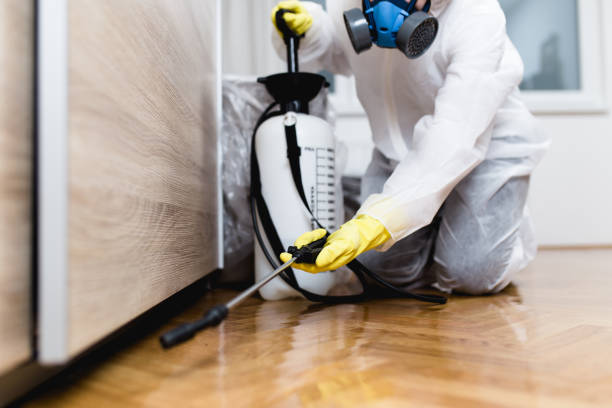When it comes to maintaining the structural integrity of houses and businesses, as well as maintaining hygiene and health, pest control services are essential. Through the utilisation of a wide variety of methods and instruments, these services can efficiently manage and eliminate pests.
Professionals in the field of pest control apply a wide range of strategies, ranging from more conventional approaches such as chemical treatments to more contemporary ways such as integrated pest management (IPM).

These strategies are adapted to meet the specific requirements and difficulties of each case. It is the purpose of this article to investigate the many resources and approaches that pest control services utilise to provide their customers with an environment that is free of pests.
What Is Pest Control?
The management and regulation of unwanted organisms, which are more frequently referred to as pests, that constitute a threat to human health, property, agriculture, and the environment is what is meant by the term “pest regulation and control.”
The identification, prevention, and elimination of pests are all aspects of this activity, which is carried out using a wide variety of approaches and procedures that are adapted to unique circumstances.
Pest control professionals employ a variety of techniques, including chemical, biological, mechanical, and cultural approaches, to efficiently manage pest populations while minimising the amount of damage caused to creatures that are not the intended targets and to the ecosystem.
The purpose of pest control is to reduce the dangers that are associated with infestations and to guarantee that individuals, communities, and ecosystems are provided with an environment that is safe, healthy, and free of pests. This can be accomplished by managing insects, rats, birds, or any other nuisance pests.
What Do Pest Control Services Use?
Pest control services employ a variety of tools, techniques, and substances to manage and eliminate pests. Here are some common methods and substances used by pest control professionals, read more here:
- Chemical pesticides are substances specifically formulated to kill or repel pests such as insects, rodents, and other unwanted organisms. Chemical pesticides may come in various forms, including sprays, baits, dusts, and fumigants.
- Biological control agents: Certain natural predators, parasites, or pathogens are used to control pest populations. For example, introducing beneficial insects like ladybugs or parasitic wasps can help control aphids or caterpillars in gardens.
- Mechanical traps: Traps are devices designed to capture or kill pests, such as mousetraps, sticky traps for insects, and live traps for larger animals like raccoons or squirrels. These traps are often used in conjunction with other pest control methods.
- Integrated pest management (IPM): IPM is a holistic approach that combines multiple strategies to manage pests effectively while minimizing environmental impact and ensuring the safety of humans and non-target organisms. This approach may involve a combination of physical, cultural, biological, and chemical control methods tailored to the specific pest problem.
- Pest monitoring and inspection: Regular monitoring and inspection of the property help identify pest infestations early and determine the most appropriate control measures. Pest control professionals may use various tools and techniques, such as pheromone traps, visual inspections, and monitoring devices, to assess the extent of the infestation and track pest activity over time.
- Exclusion techniques: Pest control services may prevent pests from entering buildings or structures, such as sealing cracks and crevices, installing screens on windows and doors, and implementing proper sanitation practices to eliminate food and water sources.
- Heat treatments: Heat can be used to control certain pests, such as bed bugs, by raising the temperature to levels that are lethal to the pests but safe for humans and pets. Heat treatments may involve using specialised equipment to heat the infested area to a precise temperature for a specified period.
Pest control services utilize a combination of these methods and techniques to address pest problems effectively while minimizing risks to human health and the environment. The specific approach used will depend on factors such as the type of pest, the severity of the infestation, and the preferences and needs of the client.
Why Is Pest Control Important?
Pest control is important for several reasons:
- Protecting health: Many pests can carry and transmit diseases to humans and animals. For example, mosquitoes can transmit diseases such as malaria, dengue fever, and Zika virus, while rodents can spread illnesses like salmonellosis and leptospirosis. Controlling pests helps reduce the risk of these diseases spreading and protects public health.
- Preventing property damage: Pests such as termites, rodents, and carpenter ants can cause significant damage to buildings, furniture, and other structures. Termites, for instance, can chew through wood, causing structural damage that can be costly to repair. Effective pest control measures can help prevent such damage and preserve the integrity of properties.
- Preserving food supplies: Pests such as insects and rodents can contaminate food supplies and damage crops, leading to significant losses for farmers and food producers. By controlling pests, food safety can be maintained, ensuring that crops are protected and food supplies remain safe for consumption.
- Protecting the environment: Some pest control methods, such as integrated pest management (IPM), focus on minimizing environmental impact by using less toxic pesticides and emphasizing preventive measures. By employing sustainable pest control practices, biodiversity can be preserved, and ecosystems can remain healthy.
- Enhancing quality of life: Pests can be a nuisance, causing discomfort and inconvenience for homeowners, businesses, and communities. For example, cockroaches and bed bugs can infest homes, causing stress and sleep disturbances for residents. Effective pest control helps improve the quality of life by reducing pest populations and creating a more comfortable living and working environment.
- Safeguarding property values: Pest infestations can decrease property values and deter potential buyers or tenants. Properties with a history of pest problems may be perceived as less desirable and may require extensive repairs or treatments to address infestations. Regular pest control measures can help maintain property values and protect investments in real estate.
Pest control plays a crucial role in protecting public health, preserving property, safeguarding food supplies, and maintaining environmental sustainability. By implementing effective pest management practices, individuals and communities can mitigate the risks associated with pest infestations and ensure a safer, healthier environment for all.
Conclusion
Controlling pests is a crucial component in the process of preserving an environment that is secure, healthy, and comfortable for all living things, including humans, animals, and the ecosystem as a whole.
Protecting public health, preventing damage to property, preserving food supplies, protecting the environment, improving quality of life, and maintaining property values are all possible outcomes that can be achieved through the appropriate management and elimination of pests.
Pest control professionals can address pest infestations while simultaneously minimising threats to human health and the environment by employing a variety of pest control strategies. These methods include chemical pesticides, biological control agents, traps, integrated pest management (IPM), and exclusion measures.
In the end, investing in pest control techniques is not only a proactive step towards preventing prospective difficulties, but it is also a responsible way to protect the well-being and safety of individuals, communities, and the world as a whole.
When we make pest control a top priority, we can make the settings in which people live and work healthier and more environmentally friendly for everyone.
